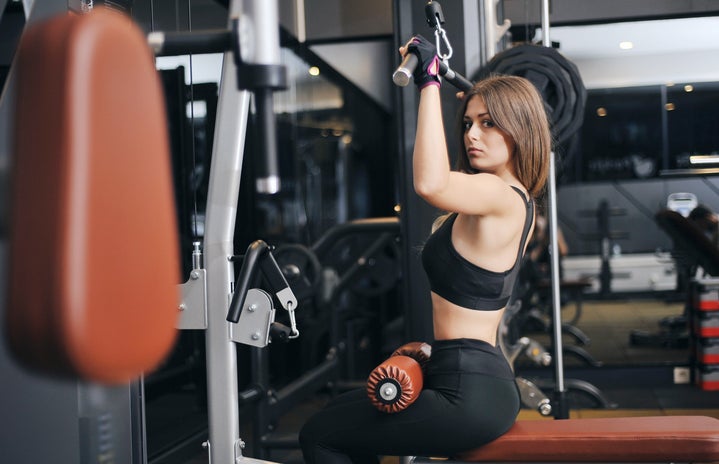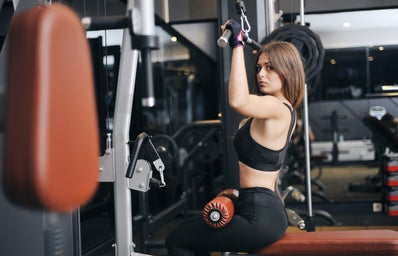As masks are currently still mandatory with the ongoing pandemic, people are required to wear a mask to the gym or while exercising outside of their home. I have tried this, and as a certified fitness instructor, I do not recommend it. Here’s why.
I’ll start with my personal experience.

I wore a mask to my university gym when it first reopened after the COVID-19 outbreak. I went pretty regularly at first. I had to make some adjustments to my workout routine. I felt myself getting too out of breath when doing cardio, so I had to cut that out, which was disappointing. I found myself exhausted after every workout, and breathing was difficult. I decided to try out some private gyms in my area that did not require masks when exercising. I noticed that I was instantly able to lift more weight, stay at the gym for longer working out and get the most out of my workout. I was finally able to do cardio again, which helped me feel a lot better when I needed to get my heart rate up. Gyms were relatively empty during this time, taking all necessary precautions to keep clients safe.
Around this time, I also started teaching group fitness classes at a local studio called Drip Drop Fitness. Our staff is dedicated to making sure the studio as safe as possible for clients by sanitizing everything, taking client temperatures, only allowing clients in three minutes before class, spacing out clients six feet apart and many more measures that go on behind the scenes. We wear masks to check-in clients before teaching. We do not require that clients or instructors wear masks during the class. We follow the mask mandate for Florida, which specifies that people do not have to wear a mask while exercising. I teach an upbeat Pilates class where breathing is a vital component of the workout. This applies especially to Pilates, which has a plethora of key breathing techniques that help practice specific exercises correctly, namely the hundreds. With a mask on, I do not believe clients would receive the total benefits the class has to offer and would struggle greatly during more challenging sections of the class such as the cardio-based routines I implement in each class. I am AFAA certified in Group Fitness and Pilates.
Now, here are some facts.
The Centers for Disease Control and Prevention (CDC) urges people to wear masks while exercising, even at the most intense levels of exercise. They stress that transmission of COVID-19 is increased where higher levels of breathing are present, such as gyms. The CDC states that it is not dangerous or unhealthy to wear a mask while exercising unless one has prior health conditions such as a respiratory illness. While they have conducted studies analyzing these facts, people have not been wearing masks long enough for us to know the long-term effects of exercising with face coverings on.
The World Health Organization’s stance differs from that of the CDC. On WHO’s website, it states that one should never wear a mask while exercising. WHO explains that wearing a mask during vigorous physical activity risks reducing one’s breathing capacity. Instead, they urge people to make sure the indoor facility they are exercising in has good ventilation and to keep their distance from others.
What exactly happens within our bodies while exercising?

Whether we are lifting weights, running or even doing Pilates, our body recognizes exercise and responds. Our muscles produce lactic acid as we participate in heavy exercise. This causes the burning sensation we feel during a workout. This lactic acid then converts to carbon dioxide and is exhaled. But if the carbon dioxide we breathe out is trapped by a mask, we may be breathing in carbon dioxide. This can reduce cognitive function and increase breathing rate. We need up to 15 times more oxygen when we work out, which is why we tend to breathe heavier as we exercise. This increased breathing rate from our bodies is natural; it is an attempt to bring more oxygen to our muscles. However, when this path is impeded by a mask, this disallows a sufficient amount of oxygen to enter the body during high-intensity movement.
Using school athletics as an example, sporting administrators are exploring ways to enable a safe return to training for athletes. They have found that “a mask makes it harder to inhale the quantity of air needed to perform at the highest levels. We know that wearing a surgical mask can increase the resistance to airflow. Exercise invariably leads to faster and harder breaths, so wearing a mask during exercise places a further strain on airflow.” Athletes especially are made to challenge themselves on and off the field, and the mask hinders them with resistance to their breathing flow.
As more people feel comfortable entering gyms, mask requirements should be researched and thoroughly investigated before requiring people to wear a mask while performing exercise. As someone who works in the fitness industry, I believe strongly in the importance of proper breathing during exercise, which is not possible with masks. People’s health and safety should be the priority of fitness centers—not their reputation.
Want to see more HCFSU? Be sure to like us on Facebook and follow us on Instagram, Twitter, TikTok, Youtube and Pinterest!

